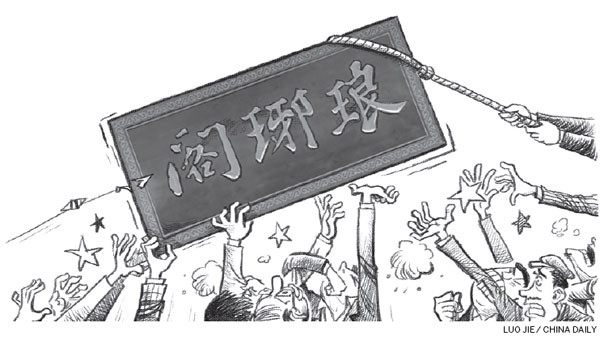Use a site's real strengths to draw tourists
Updated: 2015-11-23 08:37
By Xiao Lixin(China Daily)
|
|||||||||

After premiering in mid-September, TV series Nirvana in Fire, or Langya Bang in Chinese, has become very popular among Chinese viewers. But this is not surprising because Langya Bang could also mean "The Rankings of Langya", for which Anhui, Jiangsu and Shandong provinces had been competing with each other. The competition has temporarily ended with Chuzhou city in Anhui renaming the "Huifeng Pavilion" in the Mount Langya scenic area "Langya Pavilion".
Officials in the Chuzhou administration committee have said the move is meant to "cater to the need of tourists who wanted the pavilion to be renamed", not to attract more tourists by applying to get recognized as a 5A scenic spot as many have suspected.
Given the thriving tourism market, tourist spots in the country have been racking their brains to find new ways to attract more tourists and increase their revenues. And many local tourism authorities have come to believe that capitalizing on the success of hit films or TV productions which highlight breathtaking sceneries is one way of drawing more visitors.
For example, thanks to the 2008 blockbuster If You Are The One, Hokkaido in Japan and Xixi Wetland Park in Hangzhou, Zhejiang province, have become big attractions for Chinese tourists. And following the release of Avatar, Zhangjiajie in Hunan province has not only generated online discussions, but also seized the opportunity to offer Avatar-themed tour packages, because the landmark Hollywood film's director James Cameron was reportedly inspired by the craggy natural formation of its famous peak, the South Pillar of Heaven, to create the floating Hallelujah Mountain in the film.
Coming back to the Huifeng Pavilion whose history dates back to the Ming Dynasty (1368-1644), the local tourism management's move to rename it could attract more tourists in the short term, but by associating the scenic spot with the hit TV series it will end up dealing a blow to the cultural heritage of the place. After all, the TV series has nothing to do with the tourist spot apart from sharing the name Langya.
Local authorities should realize that attempts to promote tourist spots cannot be successful in the long run if their social influence and historical significance are ignored, especially if the sole motive is to make more money.
Scenic spots keep attracting visitors not only because of their picturesque landscape and beautiful surroundings, but also, and more importantly, because of their historical and cultural values that make them different from others. Therefore, tourist spot managements should promote the core attractive aspects and distinctive features of a site to acquire the competitive edge in the tourism market, and stop trying to club two totally unrelated things together to fool the public.
In fact, Chuzhou's Mount Langya has a pretty rich cultural history associated with it, such as the masterpiece, Story of Old Tippler's Pavilion, written by Ouyang Xiu after he was appointed the governor of Chuzhou, and the eastern Anhui culture represented by the Fengyang flower-drum dance. It is thus surprising that despite having ample local cultural treasures and resources which can be used to promote tourist sites and increase economic returns, some local authorities make silly, short-term efforts to attract more tourists.
Aside from creating and enhancing the cultural distinctiveness of a scenic area, it is also important to impress visitors with high-quality tourist services and products, especially because many domestic tourist destinations fail to please visitors. Hence, local tourism authorities should focus on these aspects, instead of trying to hitch a free ride on the success of a film or TV production to increase their revenues, because such attempts cannot fool people for a long time.
The author is a writer with China Daily. xiaolixin@chinadaily.com.cn
- Langya Mountain Scenic Area opens free to Chuzhou locals
- Organizers look to boost tourism through event
- Six cities join hands to promote Shandong peninsula tourism
- Winter tourism booming in China's West
- China's inbound tourism rebounding
- Rural tourism to protect ethnic culture in Guiyang
- Pu'er promotes its tourism at CITM
- Global health entering new era: WHO chief
- Brazil's planning minister steps aside after recordings revelation
- Vietnam, US adopt joint statement on advancing comprehensive partnership
- European border closures 'inhumane': UN refugee agency
- Japan's foreign minister calls A-bombings extremely regrettable
- Fukushima impact unprecedented for oceans: US expert

 Stars of Lijiang River: Elderly brothers with white beards
Stars of Lijiang River: Elderly brothers with white beards
 Wealthy Chinese children paying money to learn British manners
Wealthy Chinese children paying money to learn British manners
 Military-style wedding: Fighter jets, grooms in dashing uniforms
Military-style wedding: Fighter jets, grooms in dashing uniforms
 Striking photos around the world: May 16 - May 22
Striking photos around the world: May 16 - May 22
 Robots help elderly in nursing home in east China
Robots help elderly in nursing home in east China
 Hanging in the air: Chongqing holds rescue drill
Hanging in the air: Chongqing holds rescue drill
 2.1-ton tofu finishes in two hours in central China
2.1-ton tofu finishes in two hours in central China
 Six things you may not know about Grain Buds
Six things you may not know about Grain Buds
Most Viewed
Editor's Picks

|

|

|

|

|

|
Today's Top News
Liang avoids jail in shooting death
China's finance minister addresses ratings downgrade
Duke alumni visit Chinese Embassy
Marriott unlikely to top Anbang offer for Starwood: Observers
Chinese biopharma debuts on Nasdaq
What ends Jeb Bush's White House hopes
Investigation for Nicolas's campaign
Will US-ASEAN meeting be good for region?
US Weekly

|

|









